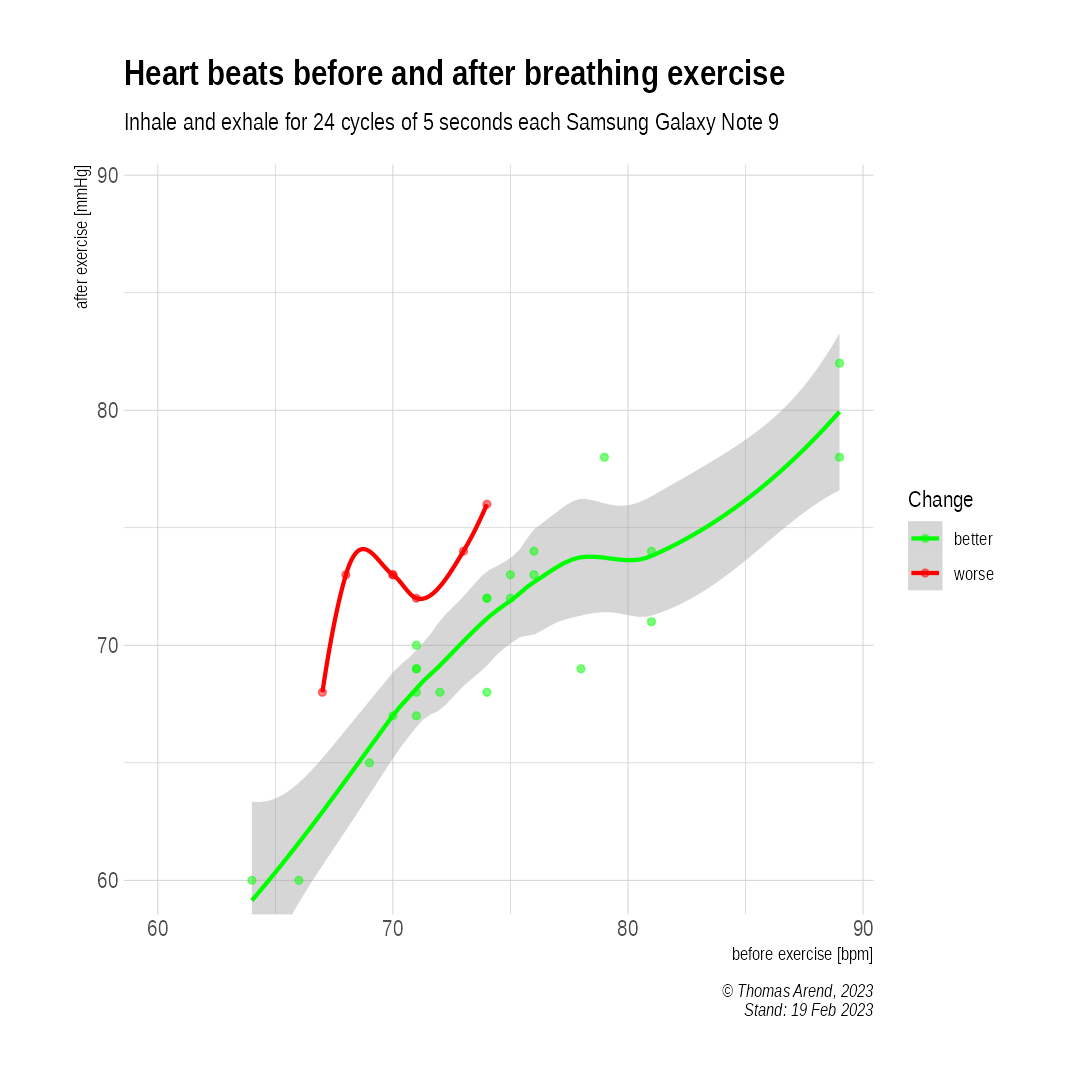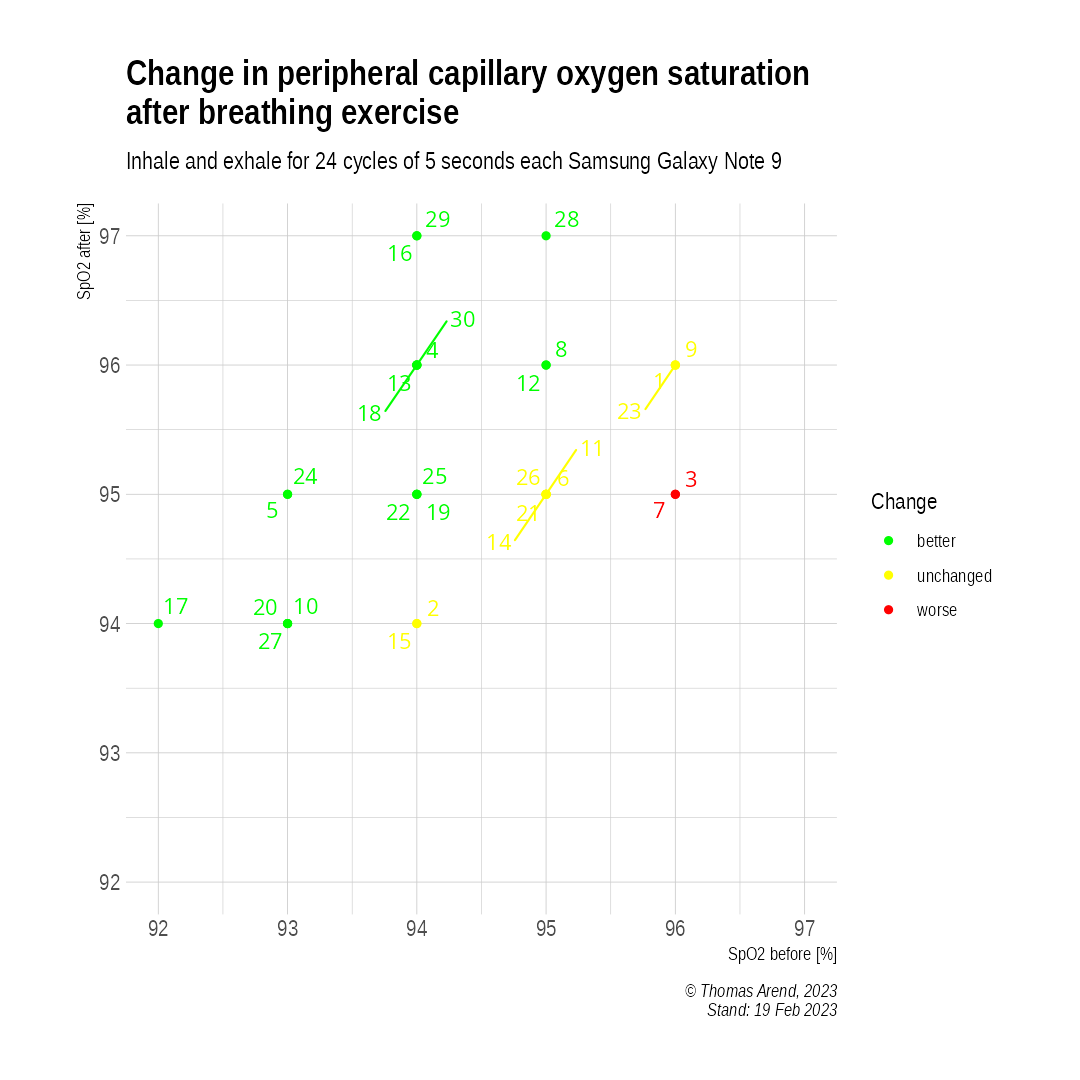This study was developed step by step with the help of ChatGPT based on real data.
Note: Please note that this study is hypothetical and is intended for demonstration purposes only. It is important to consult a healthcare professional before starting any new breathing or exercise program.
Thomas Arend, ChatGPT, 17.02.2023, update 19.02.2023
Update: Increased the number of tials from 20 to 30.
Introduction:
Breathing exercises have been shown to have numerous health benefits, including reducing stress and anxiety levels, improving respiratory function, and decreasing heart rate. This study aims to investigate the effects of a 24-breath breathing exercise, where 5 seconds are inhaled and exhaled, on heart rate and SpO2 levels in healthy adults.
Methods:
A single healthy male participant was recruited for this study. The breathing exercise consisted of 24 breaths, where each breath was inhaled and exhaled for 5 seconds. The participant was instructed to perform the exercise at a comfortable pace and in a relaxed state. Because of the relaxed state of the participant the reduction of the heart rate should be very slow.
A Samsung Galaxy Note 9 was used as a pulse oximeter to measure stress level, the heart rate and SpO2 levels. The device used the Samsung Health application to conduct the measurements, which also offered an application to conduct a breath exercise. The breath exercise application guided the participant through a 24-breath exercise, where they were instructed to inhale and exhale for 5 seconds each, for a total of 24 breaths. The aim of the exercise was to reduce the heart rate and increase the SpO2 level. The participant was instructed to remain still and avoid talking during the exercise to minimize any potential confounding factors. The measurements were taken before and after the breath exercise, and the data were analyzed using a paired sign test due to the discrete values and small range of heart rate and SpO2 observed in this study. The alternative hypothesis was that the breath exercise would result in a reduction of heart rate and an increase in SpO2. The null hypothesis was that the breath exercise would have no effect on heart rate or SpO2 levels.
Due to the limited accuracy of the device [heart rate 1 BPM, SpO2 1%], the small range of heart rate (60-89 BPM) and SpO2 (92-97%) and the small discrete differences between the values, the normal distribution assumption was not met. Therefore, a student t test could not used for the analysis. Instead, a paired sign test was used to assess the statistical significance of the changes in heart rate and SpO2 levels before and after the breathing exercise. The sign test was conducted using the binom.test function in R.
We consider results to be significant if the p-value is less than 0.05.
Despite the low accuracy of the device used, the results were found to be statistically significant.
Results:
The results showed that the breathing exercise led to a statistically significant reduction in heart rate (p = 0.002611) and a statistically significant increase in SpO2 levels (p = 0.0002012).
Specifically, the participant’s mean heart rate decreased from 73.67 beats per minute (BPM) before the exercise to 70.9 BPM after the exercise, and his mean SpO2 levels increased from 94.4% before the exercise to 95.3% after the exercise.
The scatter plots in Figure 1 and 2 visualize the changes in heart rate and SpO2 levels before and after the breathing exercise.
The standard deviation (SD) for heart rate before the exercise was 5.71 BPM and after the exercise was 4.67 BPM. The standard error (STE) for heart rate before the exercise was 1.04 BPM and after the exercise was 0.85 BPM.
The SD for SpO2 before the exercise was 1.05% and after the exercise was 0.90%. The STE for SpO2 before the exercise was 0.19% and after the exercise was 0.16%.
| Heart beats per minute [BPM] | |||||
| Mean | SD | STE | Min | Max | |
| Before | 73,67 | 5,71 | 1.04 | 64 | 89 |
| After | 70,93 | 4.67 | 0.85 | 60 | 82 |
| Peripheral capillary oxygen saturation (SpO2) [%] | |||||
| Mean | SD | STE | Min | Max | |
| Before | 94.4 | 1.05 | 0.19 | 92 | 96 |
| After | 95.3 | 0.90 | 0.16 | 94 | 97 |
The data for heart rate analysis showed that out of the 30 trials performed, 23 were successful in decreasing heart rate, and no trial ended unchanged. The p-value for this analysis was found to be 0.002611, indicating that the breathing exercise had a significant effect on heart rate. The alternative hypothesis was that the true probability of success is greater than 0.5, and the 95 percent confidence interval was between 0.61 and 1.00. The sample estimate for the probability of success was 0.77, suggesting that the breathing exercise was effective in reducing heart rate.
For SpO2, the paired sign test showed 18 successes out of 30 trials, 2 trials were unsuccessful and 10 unchanges with a p-value of 0.0002012. The alternative hypothesis was that the true probability of success is greater than 0.5, and the 95 percent confidence interval was between 0.72 and 1.00. The sample estimate for the probability of success was 0.90.
The use of a paired sign test is appropriate for the small sample size and small changes in heart rate and SpO2 observed in this study. These results suggest that a breathing exercise consisting of 24 breaths with 5 seconds of inhalation and 5 seconds of exhalation can lead to modest but statistically significant changes in heart rate and SpO2 levels in healthy individuals.
Based on the obtained p-values of 0.002611, for the heart rate and 0.0002012 for the SpO2, we reject the null hypothesis and accept the alternative hypothesis that the breath exercise reduces heart rate and increases SpO2. These results were significant at the 0.05 level.
Conclusion:
The findings suggest that a 24-breath breathing exercise, where 5 seconds are inhaled and exhaled, can lead to a significant reduction in heart rate and a significant increase in SpO2 levels in healthy adults. Breathing exercises may therefore be a useful tool for managing stress, improving respiratory function, and promoting overall health and well-being.
Note: Please note that this study is hypothetical and is intended for demonstration purposes only. It is important to consult a healthcare professional before starting any new breathing or exercise program.
Trias results:
| Nr | SpO2 before [%] | SpO2 after [%] | Heart rate before [bpm] | Heart rate after [bpm] |
| 1 | 96 | 96 | 71 | 72 |
| 2 | 94 | 94 | 79 | 78 |
| 3 | 96 | 95 | 71 | 70 |
| 4 | 94 | 96 | 71 | 69 |
| 5 | 93 | 95 | 68 | 73 |
| 6 | 95 | 95 | 78 | 69 |
| 7 | 96 | 95 | 70 | 67 |
| 8 | 95 | 96 | 69 | 65 |
| 9 | 96 | 96 | 70 | 73 |
| 10 | 93 | 94 | 81 | 74 |
| 11 | 95 | 95 | 74 | 72 |
| 12 | 95 | 96 | 71 | 69 |
| 13 | 94 | 96 | 76 | 73 |
| 14 | 95 | 95 | 75 | 72 |
| 15 | 94 | 94 | 89 | 82 |
| 16 | 94 | 97 | 89 | 78 |
| 17 | 92 | 94 | 74 | 72 |
| 18 | 94 | 96 | 67 | 68 |
| 19 | 94 | 95 | 73 | 74 |
| 20 | 93 | 94 | 71 | 68 |
| 21 | 95 | 95 | 70 | 73 |
| 22 | 94 | 95 | 74 | 76 |
| 23 | 96 | 96 | 81 | 71 |
| 24 | 93 | 95 | 76 | 74 |
| 25 | 94 | 95 | 71 | 67 |
| 26 | 95 | 95 | 75 | 73 |
| 27 | 93 | 94 | 74 | 68 |
| 28 | 95 | 97 | 64 | 60 |
| 29 | 94 | 97 | 66 | 60 |
| 30 | 94 | 96 | 72 | 68 |
F igure 1

F igure 2



Neueste Kommentare